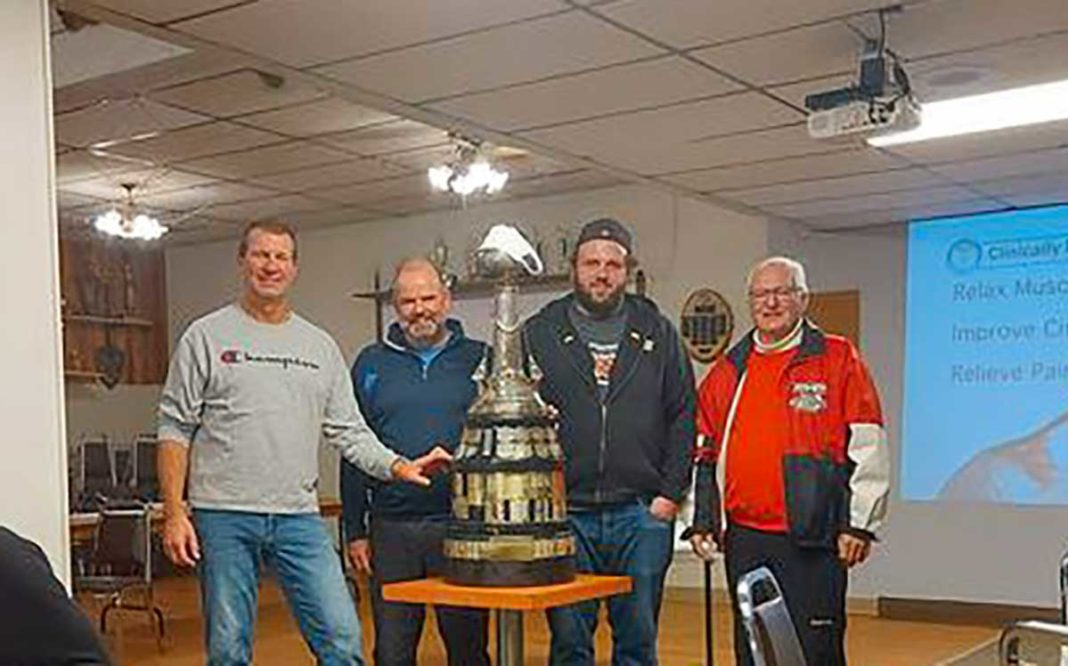ESPANOLA – The Espanola Curling Club team was successful in winning the 2020/2021 playoff for the 96th Baxter Cup against the team from the Little Current Curling Club.
“We did win this year,” said Dennis Shepitka, a spokesperson for the Espanola Curling Club. “Both clubs lost the last season of curling due to the COVID-19 pandemic. But both clubs wanted to make sure a winner was declared for 2020-2021 to keep the continuous annual run of the cup since 1925 going.”
“We wanted to make sure we completed the second match in Espanola before the 2021-2022 curling season started, and we were able to accomplish that so that we have a winner declared for 2020-2021.”
Mr. Shepitka explained, “early in 2020, after the first match of games was held in Little Current, the Espanola Curling club was shut down due to the pandemic. The second match could not be played until last weekend (the last weekend in October). The total score was 21-12 in favour of Espanola. The Baxter Cup is one of the longest continuously sought-after trophies in the sporting world.”
“No one had any practice this year so far before we played for the Cup, but everyone made a good run and everyone seemed to enjoy themselves,” said Mr. Shepitka. He pointed out 12 players took part from each of the curling clubs.”
Mr. Shepitka pointed out the Baxter Cup will be celebrating its 100th anniversary in four years.
The cup is named after George Baxter, a businessman in Little Current who introduced the annual friendly two-game competition in 1925.
Dave Cutler wrote in Curling Day in Canada January 28, 2021, “Along the northern shore of Lake Huron in Northern Ontario lie the communities of Little Current and Espanola. Even before there was a road there was a rail connection between the two communities. It developed into a friendly curling competition and the coveted Baxter Cup.”
“After a friendly game between teams from the two towns, the players headed to the nearby hotel to get warmed up,” wrote Mr. Cutler. “After several attempts to quench their thirst, the determined curlers decided to continue the game by throwing “thunder mugs” (bed pans) up and down the halls of the hotel.”
“George (Baxter) decided, after some serious and sober thoughts, that this event should be held annually, using real stones and real ice. He would provide the trophy. So, in 1925 the Baxter Cup Competition began,” wrote Mr. Cutler.
Mr. Cutler explained, “There were no roads then, only a rail line. The visitors would load their rocks on the train, a slow ride with time to socialize and develop your game plan. Each player had their own set of rocks, all different sizes and weights. Once at the designation they would unload their equipment then proceed to the curling club to prepare for the games.” The rocks were often loaded at the front of the engine to keep them frozen and “keen” for the games.
“Of course, you had to socialize and refresh and recharge before the games,” continued Mr. Cutler. “Then they curled, and afterwards they would socialize and refresh themselves some more. Sooner or later, they had to get the rocks back to the train, load them all up, then head home. This could take three or four days, weather permitting.”
“They then would anxiously await the arrival of the other guys a week or so later so they could start all over again. Thank goodness this happened only once a year!” wrote Mr. Cutler.
“The facilities have improved over the years,” he continued. “In the early days, Little Current played in a two sheet “barn.” The two (12 foot) sheets were converted to three (10 foot) sheets. This meant a rock could be in two adjacent houses at the same time. Today, Little Current has four regulation size sheets attached to the recreation complex.”
“Espanola also made improvements over the years,” explained Mr. Cutler. “The club started as a converted bunkhouse once used to house road workers, bridge builders, and mill construction workers. This was located near where the present regional complex stands. This building burned down and for years curling was done on outdoor rinks. In 1951, a new arena was built and beside it the new curling club was erected. There have been many improvements and upgrades over the years.”
Originally, the Baxter Cup games were 12 ends (natural ice in February), but this changed to 10 ends and the number of games increased to 10 from 8.
“The yearly event continues to this day and curlers in both communities look forward to continuing the competition, camaraderie, jokes, speeches, and of course a fine meal,” continued Mr. Cutler. “Total score of the ten games (five at each club) determines the winner. Four trustees, two from each club, see to it the tradition continues.”
“It started in 1925, survived the depression, accidental dips in the North Channel, the Cup being stolen (and found), World War II, and horrendous weather. Each side has several players who have participated for 20 or more years. This year is the 96th and somehow, despite the pandemic, this dedicated bunch of crazy curlers will find a way to continue the tradition,” added Mr. Cutler.




